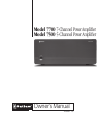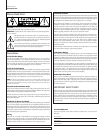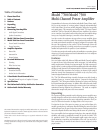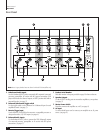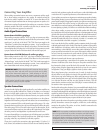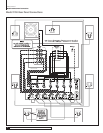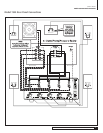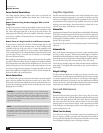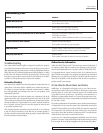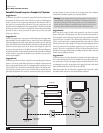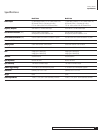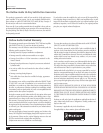
8
Outlaw Audio
Owner’s Manual
Amplifier Operation
Power Control Connections
Your Outlaw amplifier features a built-in remote turn-on system that will
automatically switch the amplifier when another device in the system is
switched on.
Remote Turn-On Using Products Equipped With a 12 Volt
Trigger Jack
Press the front panel power switch on the amplifier so that it is in the ON posi-
tion. Then, using an accessory cable with a 3.5mm mono mini-plug on each
end, connect the trigger-output jack on the rear of the source device to the
trigger input jack on the back panel of the amplifier. When these connections
are made, the amplifier will automatically turn on whenever the triggering
device is turned on.
Remote Turn on Using External AC to DC Power Converter
If your processor or receiver does not have a dedicated trigger jack, it is still
possible to activate the unit for automatic turn on when a Switched Outlet
is available on the rear of the source device. To control the amplifier in this
fashion you will need a small AC to DC power converter, capable of delivering
a 6 to 12 volt DC signal. The DC voltage should terminate in a standard 3.5mm
type mini plug. This type of converter may be obtained as a Power Adapter
from many electronics retailers.
When installing, press the Main Power Switch on the front panel of the amplifier
in so that it is in the ON position. Plug the AC adapter into a switched outlet that
will be activated when you wish to have the amplifier turn on. This may be the
switched outlet at the rear of an AC receiver or other audio equipment. Connect
the 3.5mm mini-plug from the adapter to the trigger-input jack on the back
panel of the amplifier. The amplifier will now turn on and off automatically,
based on the status of the controlling device.
Power Connection
Once all audio and system connections have been made, connect the supplied
power cord to the amplifier first, and then connect it to an AC power source.
Please make certain that the amplifier is turned off and that the device con-
nected to the remote trigger input is off when connecting the power cord and
plugging it into an AC outlet.
CAUTION: Do not plug the amplifier directly into the “Switched Acces-
sory” outlet of another device! These outlets are intended for use with
low current draw products having a low current draw, such as tuners,
CD players or cassette decks. These cannot handle the high current
draw of a power amplifier. Using these outlets for a power amplifier is a
significant safety hazard.
NOTE: It is not recommended that you connect other power amplifiers
or products with a high current draw, to the same AC power circuit as
the amplifier, unless they are used with the remote power turn on and
sequencing system. The simultaneous turn-on of multiple amplifiers
on the same circuit may cause circuit breakers to trip, due to the high
current draw.
Amplifier Operation
After all connections have been made you are ready for listening. First, turn on
the source components and processor in your system. It is always a good idea
to turn on your amplifier LAST. This avoids the possibility of any turn on pops
or transients from other equipment being amplified and sent to your speakers
where they may cause damage. Always start with a low volume level on your
controller or preamp to avoid damage to your speakers.
Manual On
Simply press the front panel Power/Standby button until the light is illuminated.
There will be a short pause from the time the power is turned on until power
is applied to the speakers. This is intentional, and protects your speakers from
damage while the amplifier stabilizes. You may also hear a relay click during
start up. This is also normal.
To turn the unit off, press the Power/Standby button again. The indicator light
will go out.
Automatic On
Make certain that the connection to the processor, or other controlling device
is correct, as shown on pages 6-7 Whenever the controlling device is turned on,
the amplifier will automatically turn on after a short pause. This pause is inten-
tional, and it protects your speakers from damage while the amplifier stabilizes.
You may also hear a relay click as during start up. This is also normal.
To turn off your amplifier, simply turn off the unit that feeds the amplifier it’s
audio signals. The amplifier will automatically go into a stand by mode in a
few moments.
Output Settings
All volume and level adjustments are made at your preamp, controller or sur-
round processor. To assure proper sound field imaging, it is always a good idea
to re-set the output levels of the channels on your processor when using the
amplifier for the first time. The circuitry in your new amplifier may be different
from your previous one, and by checking the output levels you will make certain
that the processor, amplifier and speakers are properly matched.
Care and Maintenance
Cleaning
When the unit becomes dirty, wipe it with a clean, soft, dry cloth. If necessary,
first wipe the surface with a soft cloth slightly dampened with mild soapy water,
then with a fresh cloth dampened with clean water. Wipe dry immediately
with a dry cloth. NEVER use benzene, thinner, alcohol or any other volatile
cleaning agent. Do not use abrasive cleaners, as they may damage the finish
of the metal parts. Avoid spraying insecticide, waxes, polishing agents, or any
aerosol product near the unit.
When You Are Away
If you will not be using your home theater system for an extended period of
time, it is always a good idea to turn the unit off using the Power Switch on
the rear panel of the amplifier. This will prevent the automatic turn on circuits
from accidentally turning the system on during your absence.



